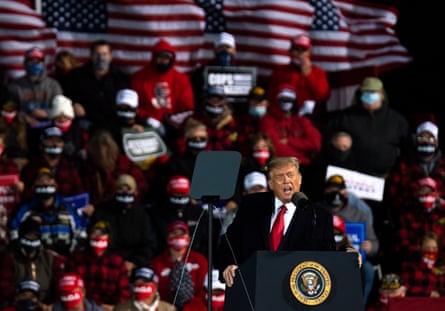Donald Trump’s administration has announced plans to let only 15,000 refugees resettle in the United States in the 2021 fiscal year that began on Thursday, setting another record low in the history of the modern refugee program and prompting outrage from civil rights groups.
The US state department said the ceiling reflects the Trump administration’s prioritizing of the “safety and wellbeing of Americans, especially in light of the ongoing Covid-19 pandemic”.
Trump, seeking re-election on 3 November, has slashed refugee admissions every year since taking office in 2017.
Critics have said that the United States under Trump has abandoned its longstanding role as a safe haven for persecuted people and that cutting refugee admissions undermines other foreign policy goals.
The Council on American-Islamic Relations, the nation’s largest Muslim civil rights organization, denounced the chipping away of the refugee program as part of “the ongoing Trump administration effort to maintain systemic anti-Black racism and white supremacy”.
Krish Vignarajah, president of Lutheran Immigration and Refugee Service, which helps resettle recently arrived refugees, wrote on Twitter that the Trump administration’s cuts represent “a complete abdication of our moral duty and all that we stand for as a nation”.
Scott Arbeiter, president of World Relief, a global Christian aid agency, said Trump has reneged on his promise to protect persecuted Christians in the world.
“Instead, we’ve seen the resettlement of refugees from countries known for persecution drop about 90% in some cases over the last four years,” Arbeiter said in a statement. “This is unconscionable.”
The administration’s plan was released hours after Trump vilified refugees as an unwanted burden for the country at a campaign rally in Duluth, Minnesota. He assailed Joe Biden, who has vowed to raise the ceiling on refugee admissions to 125,000 if elected in November.
“Biden will turn Minnesota into a refugee camp, and he said that, overwhelming public resources, overcrowding schools and inundating hospitals. You know that. It’s already there. It’s a disgrace what they’ve done to your state,” Trump told supporters.

He also condemned the Democratic congresswoman Ilhan Omar, who arrived to the United States as a Somali refugee and now represents Minneapolis, saying: “How the hell did Minnesota elect her? What the hell is wrong with you people, right?”
The refugee cap was cut to 18,000 in the 2020 fiscal year that ended on Wednesday, and only 11,814 refugees were resettled, according to the latest government figures, as increased vetting by the Trump administration and the coronavirus pandemic slowed arrivals.
US presidents typically set yearly refugee levels around the 1 October beginning of each fiscal year. Under US law, the president must consult Congress before finalizing the annual number of refugees it plans to accept, but the determination is ultimately set by the White House.
The 2021 plan lays out specific allocations, including 5,000 slots for refugees who suffered or fear persecution on the basis of religion, 4,000 slots for refugees from Iraq who helped the US, and 1,000 slots for refugees from El Salvador, Guatemala and Honduras. That leaves 5,000 for all others.
Even though 4,000 slots were allocated for Iraqis affiliated with the United States during the 2020 fiscal year, only 123 had been resettled as of 25 September, according to government figures.
A law called the Refugee Act of 1980 created the modern US refugee resettlement program. The cap set for refugees in the subsequent four decades has never been as low as the one planned for 2021. Before Barack Obama left office, he set the cap for fiscal year 2017 at 110,000 refugees, but Trump slashed that in half soon after becoming president.
Advocates have said the refugee program could take years to recover after Trump-era reductions. Tens of thousands of refugees are in the pipeline for arrival to the United States, many with applications far along in the approval and vetting process.
The Rev John L McCullough, head of the Church World Service, which helps resettle refugees in the United States, described the shrinking of refugee admissions as immoral and urged Congress to step in, though it is largely powerless to alter the administration’s determination.
“The proposed refugee resettlement number of 15,000, a more than 80% cut over historic norms, is unacceptable. Our values as a nation and as people of faith demand that we take action when people’s lives are in danger,” McCullough said in a statement.
“But for the past three years, President Trump and his administration have strayed so far from these basic principles in the name of their cruel, racist and partisan goals that the life-saving refugee resettlement program is a shadow of what it once was.”
Reuters and Associated Press contributed to this report
